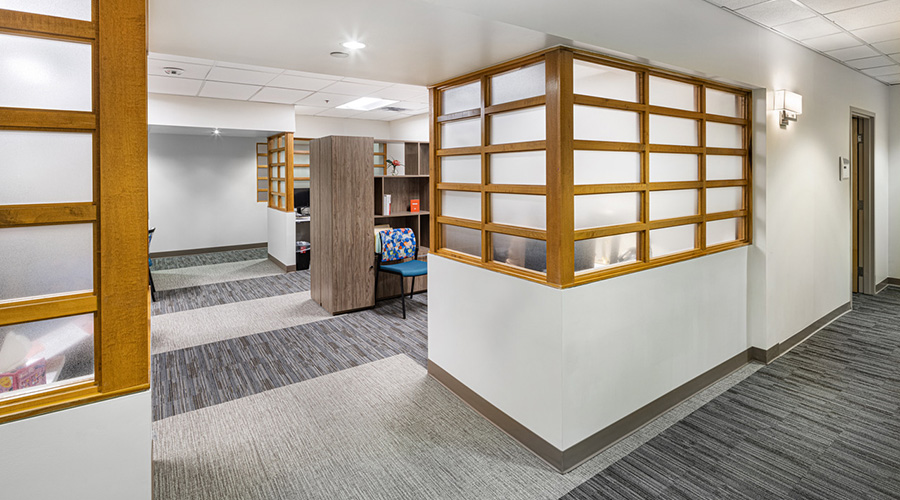While healthcare facilities are often safe havens for the sick or injured during disasters - typically maintaining operation while other public facilities are inoperative - they are not immune to their own emergencies.
From fires to earthquakes, tornadoes and more, emergency situations can directly impact healthcare facilities – and emergency lighting is required to help safely and quickly relocate or evacuate patients, care givers and visitors to safety. According to American National Standards Institute (ANSI), emergency lighting standards seek to provide visual conditions that make safe and timely evacuation possible.
While many healthcare facilities have backup generators, emergency lighting bridges any timeframe between primary lighting source failure and backup lighting to safely illuminate a medical facility, and help first responders navigate the building.
An illuminating reality
Consider a well-known tragic event in recent U.S. history – devastating Hurricane Katrina that struck New Orleans and surrounding areas in 2005. Extreme flooding forced emergency generators to power emergency lighting at the Memorial Medical Center, which was crucial to the safety of patients, visitors and staff when city power was lost.
And, natural disasters are not the only dangers healthcare facilities face. According to the National Fire Incident Reporting System (NFIRS), an average of 6,400 fires in medical facilities in the U.S. each year were responsible for approximately 5 civilian deaths, 175 injuries, and $34 million in property loss between 2004 and 2006.
Accidents are not solely limited to healthcare building occupants. According to the National Fire Protection Association (NFPA), nearly 70,000 firefighters suffered injuries on the job in 2011. And while emergency lighting is only one factor, it could dramatically impact the ability of first responders to quickly and safely reach patients and healthcare professionals, who may become disoriented during a disaster.
Understanding needs
Patients and hospital visitors are rarely, if ever, aware of the emergency precautions taken on their behalf, let alone the codes and regulations behind them. While regular occupants such as nurses, doctors and staff know emergency evacuation policies, they are also often unaware of codes and regulations that could help make evacuations smoother and safer. Yet standards exist to ensure their safety, including recommendations for specific luminaires such as exit signs and other sources of guidance, as well as the installation, operation, and testing of these products.
Additionally, consistent testing practices are critical to ensure emergency lighting is fully operational when it is needed most. Healthcare facilities are regulated by the Joint Commission to inspect facilities for processes including life safety. To meet code and safety requirements, emergency lighting must be tested regularly. The Life Safety Code mandates emergency lighting fixtures must have a monthly 30-second test, as well as an annual 90-minute test. To adhere to emergency lighting requirements, wireless, self-diagnostic testing is one of the most cost-efficient and maintenance-efficient ways to test and document emergency lighting test results.
A mixture of local and national codes, including the National Electrical Code (NEC), OSHA Code of Federal Regulation, NFPA 101 and NFPA 70, have been developed and put into practice to help protect the general public in times of disaster.
The majority of these codes effectively address important lighting needs during an emergency. High-performance LED emergency lighting provides the opportunity to deliver the brighter lighting for an extended period of time. Additionally, there are several key considerations when specifying emergency lighting that help exceed code standards and ensure a safe environment for building occupants:
1. Emergency lighting should be energized by a connection independent of the general lighting in the space. Use lighting that features options with multiple battery packs for maximum remote capacity and run time.
2. The design of egress, including the number and placement of emergency lights, must enable prompt escape of building occupants. Thus, plan the design of where emergency lighting is placed in a building to foster an optimally illuminated escape route to create a safer atmosphere than creating a cost-efficient design.
3. Codes require timing for when and how long emergency lighting must illuminate a building when an emergency occurs. Selecting emergency lighting systems that provide enhanced visibility and constant high output LED lighting for longer than the required timeframe could increase the likelihood of a safe rescue and/or escape.
4. Maximum and minimum illumination foot-candles are outlined in codes. Choosing the maximum illumination with features such as refractive optics that provide high and uniform light levels ensures clear vision.
5. Select emergency lighting loads that are automatically energized or re-energized within 10 seconds of the electrical power outage… and that stay energized for at least 90 minutes or for the anticipated time of the building evacuation.
The ideal emergency lighting solution in healthcare facilities supports the safe and speedy exit or relocation of building occupants and provides on-scene organizers and first responders with the best possible light levels to care for patients – not just for the first few minutes, but well beyond.
A call to choose higher standards
High-performance LED emergency lighting fixtures cannot only meet, but exceed minimum emergency lighting code requirements. As with all lighting decisions, cost, ease of installation, maintenance, disposal and replacement are all key factors impacting on the decision-making process in healthcare atmospheres. However, above all factors – providing the safest possible facility should be a priority.
For example, new high-performance, long-life LEDs with more powerful battery options – both of which contain built-in redundancies – assure dependable operation for 90 minutes and beyond. Where many emergency lighting units experience decreasing light levels during the required 90 minutes of illumination, new light engine technology continues to illuminate passageways at a constant high-output level that exceeds code requirements and produces brighter illumination than traditional incandescent options.
If even a single life can be saved or an injury averted thanks to an emergency lighting solution that shines brighter, clearer and longer, the decision to exceed specification requirements can be easily justified in healthcare facilities.
In his current position at Acuity Brands® as the Lithonia Lighting® Value Stream Manager – General Purpose Emergency Products, Scott Galentine is responsible for sales, marketing and product development. During his time with the company, he has achieved three product family launches, consisting of seven unique products. He can be reached via email at Scott.Galentine@AcuityBrands.com. Visit www.lithonia.com to learn more.

 Joint Commission Standards: What Updates Matter Most?
Joint Commission Standards: What Updates Matter Most? Swinerton Completes Construction at Atlanta's Grady Hospital
Swinerton Completes Construction at Atlanta's Grady Hospital NY Governor Hochul Announces $300M in Funds for IT and Cybersecurity
NY Governor Hochul Announces $300M in Funds for IT and Cybersecurity Healthcare Is the New Retail
Healthcare Is the New Retail Bridgeway Behavioral Health Services Launches Campaign to Renovate Health Center
Bridgeway Behavioral Health Services Launches Campaign to Renovate Health Center